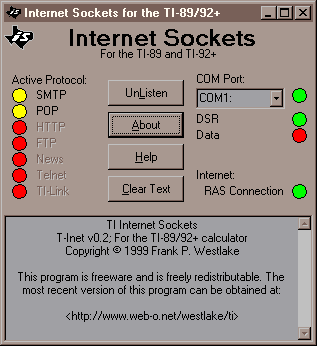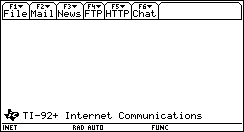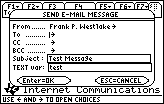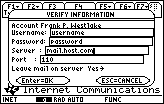



Computer:
- Windows 95 or later or Windows NT 4.0 or later. The program may work with earlier versions of either OS but I'm not able to check.
- Graph Link cable.
- Serial port.
- TI-92+ or TI-89. May work with a TI-92 but I'm not able to check.
INSTALLATION
Computer:
- Install TINET.EXE in a directory of your choice and create a shortcut in whatever menuing system you use.
- Install the group file TINET.9XG in your calculator.
CONFIGURATION
Computer:
- Run TINET.EXE and select the COM port for linking with your calculator.
Calculator:
- Run inet\setup(). This program will move inet to another folder if you desire, configure your user folders (incoming & outgoing mail, etc.), configure your list of e-mail accounts, and configure your e-mail addressbook.
- Display name (identifies the entry and is used in the From: line of messages.)
- Your e-mail address
- SMTP server
- SMTP server port (usually 25)
- POP server
- POP server port (usually 110)
- User name
- Password
- Name
- E-mail address
OPERATION
Computer:
- Select the "Listen" button. The program is now waiting for instructions and information from the calculator on the selected COM port.
- Run inet(). This program is a menuing and controlling program for all of the Internet operations.
- Select one of the operations from the menu.
You will be presented with a dialog asking you which account you wish to use for sending the e-mail message. After you select the account you will be presented with a dialog asking you to verify the account information, add a subject line if it is not already in the message, and select the message to send. This dialog will only allow you to include one of each type of addressee (To, Cc, Bcc) but additional addressee's may be included in the message.
Mail|Receive
You will be presented with
a dialog asking you to select the e-mail account you wish to receive e-mail
for. The next dialog allows you to verify the information and add a password
or any other information you didn't include in the accounts database.
MESSAGE DETAILS
E-mail messages are TEXT variables. The maximum size message that can be received is 32k. The maximum size that can be sent is whatever your calculator will allow you to create and transfer.
Received messages are stored with a variable name representing the date and time received. The first character is always 'm'. The next three characters are the month, day, and hour in base 36. The second character is the month, with 1-9 equal to January-September and a-c equal to October-December. The third character is the day, with a-v equal to 10-31. The fourth character is the hour, with a-n equal to 10-23. The last four characters are always digits representing the minutes and seconds of the hour.
Any TEXT variable can be sent as an e-mail message. Message headers can be included in the TEXT variable if desired. If headers are used they must all be at the top of the message, the first non-header line will terminate header parsing and any subsequent headers will be included as text in the message body.
A message header is identified by marking it as a Command with "F2:1 Command." Any header may be included. Header titles must be immediately followed with a colon space, i.e. "Subject: Subject line." The From: and Subject: headers will be replaced if changed at send-time. The following are examples of message headers:
C:From: <me@my.net>
C:To: <you@your.net>
C:Cc: <him@his.net>
C:Cc: <her@her.net>
C:Bcc: <it@its.net>
C:X-comment: This is a user
defined header
C:X-whatever: Another user
defined header
C:Subject: TI Internet Sockets
The text editor commands "F2:2 Page Break" and "F2:3 PrintObj" are currently ignored but are reserved for future use.